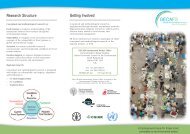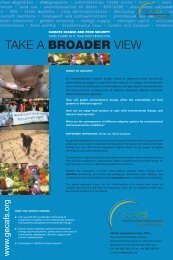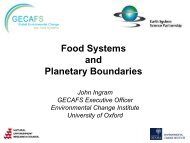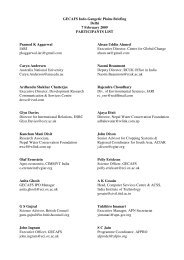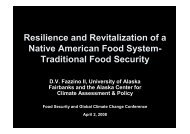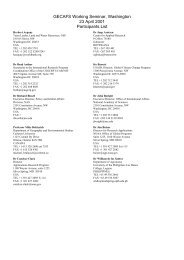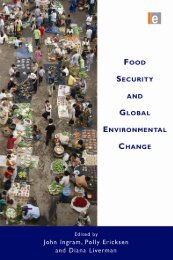2010 about 925 million people had <strong>to</strong> go <strong>to</strong> bed hungry (FAO, 2010). <strong>Production</strong> alone ismanifestly not the only fac<strong>to</strong>r. Increasingly, and especially since the 1996 World <strong>Food</strong>Summit (FAO, 1996b; FAO, 1996a), the notion of food security is not so much one of foodproduction but more relates <strong>to</strong> access <strong>to</strong> food. A further dimension is the nutritional contentand, if one also includes the fact that some two billion people are iron-deficient worldwide,the 2010 FAO estimate of 925 million food-insecure is a gross underestimate (Pinstrup-Andersen, 2009).<strong>Food</strong> security is a state or condition. It is a flexible concept as reflected in the many attemptsat definition in research and policy usage (FAO, 2003), and numerous definitions of foodsecurity thus exist. Even by 1992 Maxwell and Smith had counted over 200 (Spring, 2009),and more are still being formulated (e.g. Defra, 2006). Nonetheless, a commonly-useddefinition stemming from the 1996 World <strong>Food</strong> Summit states that food security is met when“all people, at all times, have physical and economic access <strong>to</strong> sufficient, safe, and nutritiousfood <strong>to</strong> meet their dietary needs and food preferences for an active and healthy life”. Thisdefinition built on the key work by Amartya Sen (Sen, 1981) in which he demonstrated thatfamine occurs not only from a lack of food, but from inequalities built in<strong>to</strong> mechanisms fordistributing food. So, not only does the definition bring in a wide range of issues related <strong>to</strong> afuller understanding of food security, but some key words such as “food production” and“agriculture” – which might have been expected in such a definition – are not included; theemphasis changed from increasing food production <strong>to</strong> increasing access <strong>to</strong> food for all.The majority of more recent definitions of food security share the notion of access <strong>to</strong> food asbeing the key aspect. These definitions are manifestly valuable in raising the profile of themany fac<strong>to</strong>rs that contribute <strong>to</strong> food security in addition <strong>to</strong> producing food. The nutritionaland food safety dimensions of food feature explicitly, as do the roles of wealth and foodprices which underpin the fundamentally-important notion of ‘affordability’ (“economicaccess”). Other dimensions are more implicit: the notion of “preferences” implies not onlywhat we like <strong>to</strong> eat, but also the function food plays in, for instance, our social and culturalnorms. The idea of “all people, at all times” implies both equitable allocation within societyand stability of sufficiency. Further, although again not explicit in the definition, spatiallevels higher than the agricultural plot are implied: “physical access” introduces the criticallyimportant issues of proximity, s<strong>to</strong>rage and distribution which in turn indicate the importanceof food trade locally and internationally.<strong>From</strong> an ‘industrialised world’ viewpoint, the notion of food security (or more correctly, foodinsecurity) has long been associated with ‘developing world’ issues, and has hence been thepurview of development agencies, rather than government departments and other nationalagencies concerned with domestic agendas. Indeed, until recently, ‘food security’ has notbeen a priority policy <strong>to</strong>pic in the industrialised world and in the UK, for instance, few – ifany – government documents since the Second World War included the phrase ‘foodsecurity’ in the title. Recently, however, there has been a growing realisation of the scale offuture requirements: 50% more food will be needed by 2030, and possibly 100% more meatby 2050 (Godfray et al., 2010b). This, coupled with the 2007-08 food price spike which saw2
the number of hungry people leaping 40 million in a few weeks <strong>to</strong> exceed 1 billion (FAO,2008b) has led <strong>to</strong> renewed concerns about hunger; the notion of food security has takencentre stage in many fora. While a few argue that the world will be quite capable of feedingthe predicted 2050 population of nine billion people (e.g. Paillard et al., 2011; The Times, 14January 2011), the majority view is that this is by no means certain in a sustainable manner.<strong>Food</strong> security concerns have hence rapidly ascended policy, societal and science agendas inmany countries and have been the <strong>to</strong>pic of special issues of leading scientific journals (e.g.Phil. Trans. R. Soc. B, 2010 vol 365; Science, 2010, vol 372), government documents (e.g.Defra, 2009; USDA-ERS, 2009) and leading high-circulation media such as the Economist(21 November 2009) and Time (26 Oc<strong>to</strong>ber 2009).Almost overnight governments began issuing statements about food security (in contrast <strong>to</strong>agricultural development and food production) and the media relayed these <strong>to</strong> civil society,enhancing political interest. In their July 2009 joint statement, for instance, the G8 heads ofstate agreed “<strong>to</strong> act with the scale and urgency needed <strong>to</strong> achieve sustainable global foodsecurity” (G8, 2009). Calls from research funders echoed these sentiments and ‘food security’is now commonly seen in the titles of research proposals, papers, books and other scienceoutputs. Importantly, however – and despite the high-level nature of the 1996 World <strong>Food</strong>Summit, and with it the much more holistic understanding of what is entailed in food security– a large proportion of the discussion under this banner continues <strong>to</strong> address issues related <strong>to</strong>food production rather than the broader food security concept. When addressing foodsecurity, it is crucial <strong>to</strong> take a broad view. This will of course include the fundamentallyimportantpart that producing food plays, but discussions must not be restricted <strong>to</strong> this narrowview; the impact of the 2007-08 food price spike underscored the concept of economic access<strong>to</strong> food being critically important, rather than food supply per se.An his<strong>to</strong>rical emphasis on food production researchThe food production aspects of food security have long been the subject of major scientificresearch investment. In 1843 the Rothamsted Experimental Station was established in theUK, while the latter part of the 19th century saw the rapid growth of commercial plantbreedingin Germany (Harwood, 2005). Despite these many years’ research, there is still aneed <strong>to</strong> establish how <strong>to</strong> produce more food given anticipated demand (Royal Society, 2009).However, satisfying these increased demands poses huge challenges for the sustainability ofboth food production, and the terrestrial and aquatic ecosystems and the services they provide<strong>to</strong> society (Tilman et al., 2002).Conscious of the negative environmental consequences of most current food productionmethods, it is clear that the necessary gains will have <strong>to</strong> be made in a more environmentallybenignmanner (Gregory and Ingram, 2000; Foresight, 2011). To this end, research hasincreasingly focused on the production system (rather than just on the plant or animalcomponent) seeking <strong>to</strong> increase the efficiency by which inputs (especially nitrogen and3
- Page 1 and 2: From Food Production to Food Securi
- Page 3 and 4: From Food Production to Food Securi
- Page 5 and 6: Table of ContentsAbstract .........
- Page 7 and 8: Paper 6: Undertaking Research at th
- Page 9: AbstractFood security is a conditio
- Page 14 and 15: water) are used, and reduce negativ
- Page 16 and 17: While the flow of the argument abou
- Page 18 and 19: determine interactions along and be
- Page 20 and 21: Paper 3: A Food Systems Approach to
- Page 23: From Food Production to Food Securi
- Page 26 and 27: concerns and are now issues that mu
- Page 28 and 29: the relationships between GEC and f
- Page 30 and 31: Theme 2 aims to understand how comm
- Page 32 and 33: GEC and the Food System of the Indo
- Page 34 and 35: Paper 2: The role of agronomic rese
- Page 36 and 37: These advances have resulted from a
- Page 38 and 39: Crop selection to determine mechani
- Page 40 and 41: Agronomic science is central to imp
- Page 42 and 43: Agronomic research in relation to f
- Page 44 and 45: The discussion above identifies a n
- Page 46 and 47: interventions and political inertia
- Page 48 and 49: While research on producing food ha
- Page 50 and 51: Box 1 Food system Activities and fo
- Page 52 and 53: In addition to broadening the debat
- Page 54 and 55: options. Examples already seen rang
- Page 56 and 57: Figure 3 Outcomes for 10 variables
- Page 58 and 59: Figure 4 Nine ‘planetary boundari
- Page 60 and 61: Figure 5 Environmental change, food
- Page 62 and 63:
Table 1: Indicative analysis of the
- Page 65:
From Food Production to Food Securi
- Page 68 and 69:
Trade Agreement (NAFTA) and the Eur
- Page 70 and 71:
Parry et al., 2005). Conducting foo
- Page 72 and 73:
is provided in the ESF/COST Forward
- Page 74 and 75:
Paper 5: Engaging Stakeholders at t
- Page 76 and 77:
into actions (strategies, policies,
- Page 78 and 79:
Box 2 Engaging with stakeholders in
- Page 80 and 81:
Box 3 Setting the research agenda f
- Page 82 and 83:
Third, and of considerable practica
- Page 84 and 85:
Figure 2: Organizing and understand
- Page 86 and 87:
organizations made up of numerous n
- Page 88 and 89:
Elements of good practice in stakeh
- Page 90 and 91:
Finally, it is worth noting that fo
- Page 92 and 93:
development (Lee, 1999; Gunderson a
- Page 94 and 95:
Box 7 The GECAFS stakeholder survey
- Page 96 and 97:
‘break down’ what might be a hi
- Page 98 and 99:
Paper 6: Undertaking Research at th
- Page 100 and 101:
agriculture in many parts of the wo
- Page 102 and 103:
gaps. The presence of a strong tech
- Page 104 and 105:
an average of two years to coalesce
- Page 106 and 107:
Institute for Meteorology and Hydro
- Page 108 and 109:
Identifying case study sitesResearc
- Page 110 and 111:
can both benefit from and contribut
- Page 112 and 113:
Box 5 Mapping stakeholder interests
- Page 114 and 115:
Holding planning meetings in locati
- Page 116 and 117:
This reorientation of the debate fr
- Page 118 and 119:
Importance of this type of research
- Page 120 and 121:
Integrating the food system concept
- Page 122 and 123:
awareness of the GEC issues within
- Page 124 and 125:
pollutants were then introduced as
- Page 126 and 127:
communities operating in food syste
- Page 128 and 129:
Improving input-use efficiency acro
- Page 130 and 131:
governance focuses on the range of
- Page 132 and 133:
Developing research agendas in supp
- Page 134 and 135:
The renewed approach to interdiscip
- Page 136 and 137:
BIELAK, A., HOLMES, J., SAVGÅRD, J
- Page 138 and 139:
EAKIN, H. 2010. What is Vulnerable?
- Page 140 and 141:
GODFRAY, H. C. J., BEDDINGTON, J. R
- Page 142 and 143:
INGRAM, J. S. I. & FERNANDES, E. C.
- Page 144 and 145:
LYUTSE, S. 2010. The One Billion To
- Page 146 and 147:
RAYNER, S. & MALONE, E. L. 1998. Hu
- Page 148 and 149:
UNDP 2006. The 2006 Human Developme
- Page 150 and 151:
activities “from plough to plate
- Page 152 and 153:
contribution to the science agenda:
- Page 154 and 155:
urgently needed, and - given the gr
- Page 156 and 157:
GECAFS plannenmakerij stelde vast d
- Page 158 and 159:
ieder hun eigen groep van betrokken
- Page 160 and 161:
het gebied van beheer hebben betrek
- Page 162:
Curriculum VitaeFollowing a BSc in



